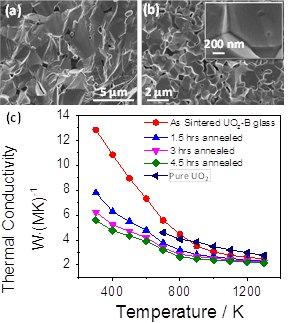To be compatible with existing reactor technology and to remain in adherence to regulations, other parameters of the fuel system must be maintained to current standards. A review of these standards and requirements was conducted. Methods of increasing thermal conductivity and oxidation resistance were reviewed, and a combination of advanced sintering techniques and adding dopants to increase thermal conductivity and create a passivation layer for oxidation resistance were selected as engineering techniques. Various materials were examined to compare performance to UO2, and composites of UO2 or U3Si2 with either Al, ZrB2, or borosilicate glass as dopants were selected for further investigation. Estimates of material properties of the composite fuels were calculated based on weight percent of dopants and qualitatively compared.
Team: Tharshana Chandrakumar, Brittany Codella, and Nathan Kane
Project Advisor: Professor Jie Lian

Project Motivation
The low thermal conductivity of UO2 makes it susceptible to extreme thermal gradients, cracking, and meltdown during loss of coolant accidents (LOCA). Additionally, even though as a ceramic UO2 has naturally high oxidation resistance, the high oxidation potential and multiple valence states of uranium can lead to highly mobile high valence uranium ions, which can diffuse out of the fuel pellets and contribute to contamination leaks. A more accident tolerant fuel (ATF) system with higher thermal conductivity and better oxidation resistance is needed.
Project Description
To be compatible with existing reactor technology and to remain in adherence to regulations, other parameters of the fuel system must be maintained to current standards. A review of these standards and requirements was conducted. Methods of increasing thermal conductivity and oxidation resistance were reviewed, and a combination of advanced sintering techniques and adding dopants to increase thermal conductivity and create a passivation layer for oxidation resistance were selected as engineering techniques. Various materials were examined to compare performance to UO2, and composites of UO2 or U3Si2 with either Al, ZrB2, or borosilicate glass as dopants were selected for further investigation. Estimates of material properties of the composite fuels were calculated based on weight percent of dopants and qualitatively compared.
Results and Accomplishments
To assess the acceptability of the fuel candidates for use in current reactors, a MATLAB code was created to assess the mechanical and thermal performance of the fuel, and a MCNP simulation was conducted to assess the neutronic performance. Calculations to assess performance were based on a Westinghouse AP1000 model reactor, because the inherent safety features allow simplifying assumptions to be made when analyzing the fuel. Additionally, the effects of fuel changes on thermal hydraulic parameters such as coolant output temperature, as well as thermal efficiency, were examined.